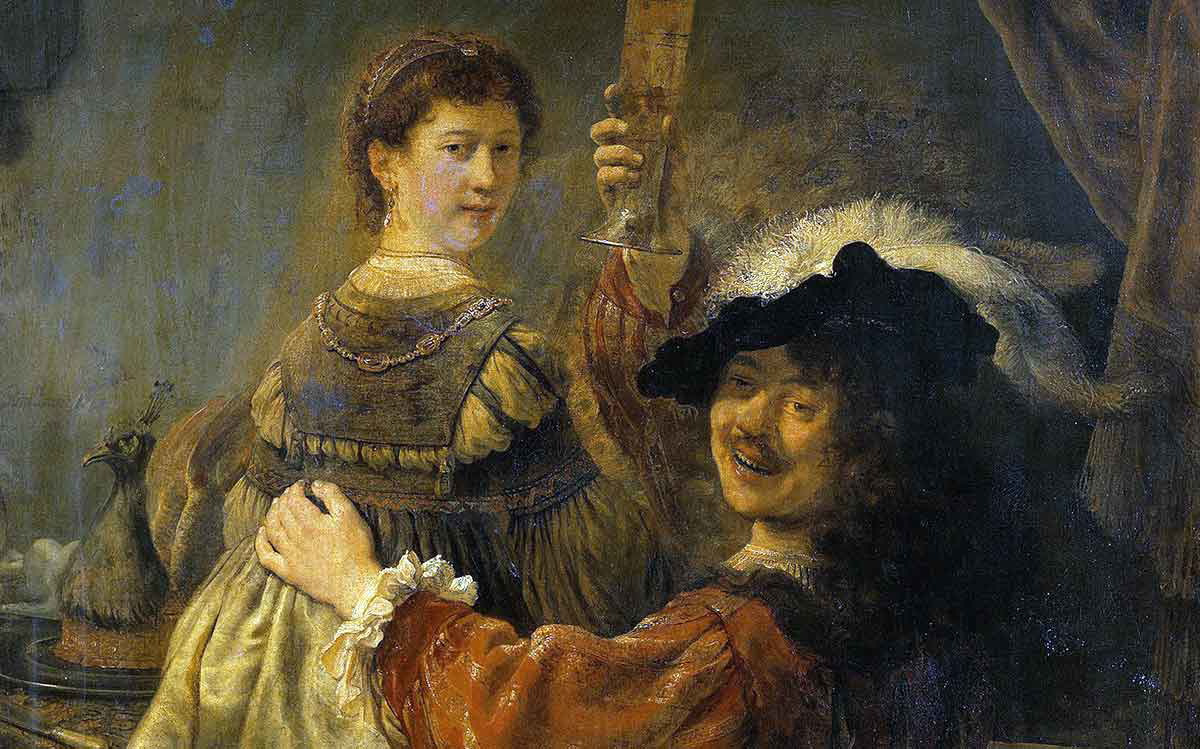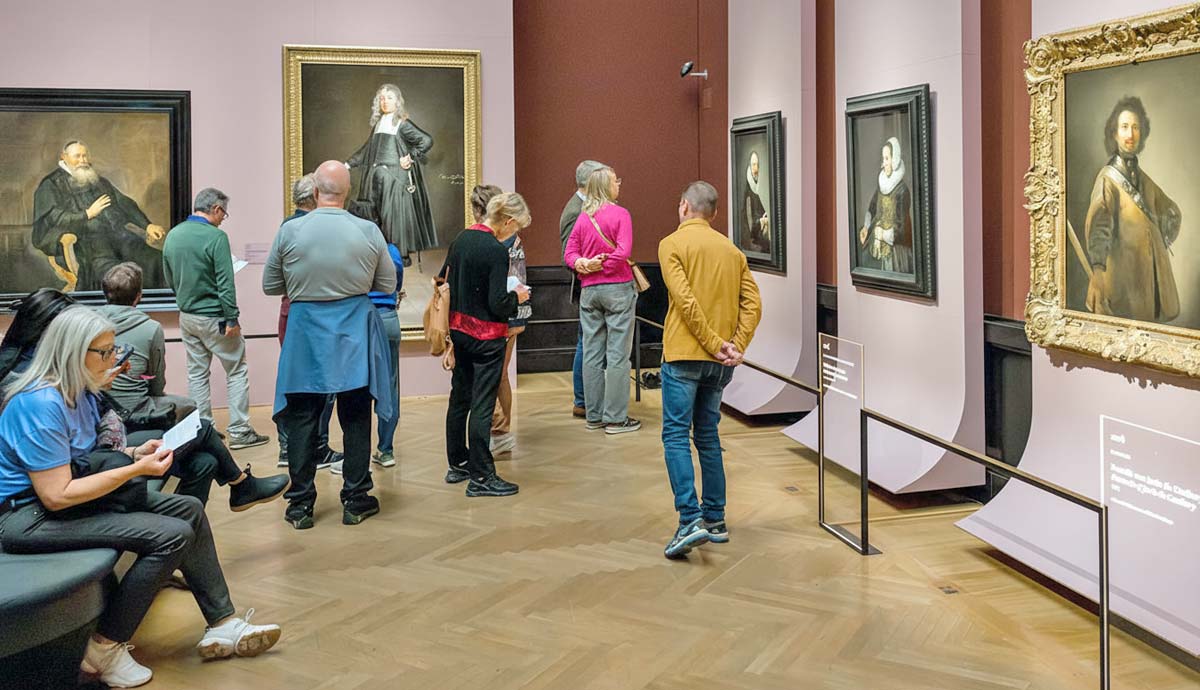
Rembrandt van Rijn was a master of light and shadow, renowned for his unique ability to create depth and emotion through his use of multi-layered painting techniques. His works, which seem to glow with life, have captivated audiences for centuries. Since his death, these masterpieces have lived on, full of mysteries, losses, and surprising revelations that continue to intrigue scholars and art enthusiasts alike. Take a closer look at the seven most famous Rembrandt paintings.
1. “The Night Watch”: The Most Famous Rembrandt Painting

The most famous painting by Rembrandt was commissioned by a unit of the Amsterdam Civic Guard. The painting is a masterpiece of group portrait and composition, as it contains 34 different characters, almost all clearly identifiable as real people and the work’s commissioners. Nonetheless, Rembrandt highlighted the most important figures by placing them in the spotlight. The central character of the scene is Captain Banninck Cocq, the unit’s leader. Contrary to its popular name, The Night Watch scene is unfolding in daylight. The misattribution happened due to old varnish that darkened with age. The actual title of the work is Militia Company of District II under the Command of Captain Frans Banninck Cocq.
Over the centuries since its creation, The Night Watch lived through many events that affected its condition. With the beginning of World War II in 1939, the canvas was rolled up and hidden inside a mountain vault near Maastricht. Moreover, The Night Watch was attacked by vandals three times: in 1911, 1975, and 1990.
2. The Anatomy Lesson of Dr. Nicolaes Tulp

Another of Rembrandt’s compositional masterpieces, The Anatomy Lesson was a commission from the Amsterdam Surgeons Guild headed by Dr. Tulp, who is seen performing a dissection. The body of the dissected man belonged to Aris Kindt who was hanged for armed robbery. Unlike many of his contemporaries who painted dissections, Rembrandt did not cover the body’s face, insisting that the surgeons dealt with real human beings. Instead, he placed a shadow over Kindt’s face to indicate his difference from the living.
Art historians doubt that Rembrandt ever personally dissected human flesh to study anatomy. Most likely, he attended dissections performed by surgeons, which were treated in his time as public entertainment for the middle and upper classes, and studied the position of bones and muscles from anatomy books. Present-day surgeons noticed the mistakes in the muscle structure that would have been avoided if Rembrandt had worked with actual human body parts.
3. Danaë

Painted in 1636, the painting was one of the most sensual works in all of Rembrandt’s career. Rembrandt’s interpretation of the Danaë myth was not intended for sale and, most likely, was painted for the artist’s home. The mythical heroine’s face was reminiscent of the artist’s wife Saskia. After Rembrandt went bankrupt and was forced to sell all his works and belongings, the painting changed several owners before being bought by Catherine the Great.
In 1985, the painting was seriously damaged after an attack by Bronius Maigys, a Soviet Lithuanian who came to the State Hermitage Museum in Leningrad (present-day Saint Petersburg) with a vial of acid, a knife, and an explosive device. After slashing Danaë’s face and body with a knife, he poured acid over the painting. Detained by museum guards and visitors, he did not manage to set off the device. Maigys claimed his attack was a patriotic act and a protest against the Soviet occupation of Lithuania. However, his mental instability, history of antisocial behavior, and portraits of Adolf Hitler found in his belongings did not work out well for his public image.
The attack caused severe damage to the painting, as a piece of paint began flaking off its central part right after the contact with acid. To preserve the work, the Hermitage conservators began spraying it with paint almost immediately. The complete restoration and conservation of Danaë took 12 years.
4. Susanna and the Elders

The 1947 painting retold the Biblical story of Susanna, who was almost assaulted by two lustful old men and wrongfully accused of adultery. This was a rather popular artistic subject that often had erotic undertones. Rembrandt avoided excessive sexualizations of Susanna, typical in works on this theme by other artists, instead presenting her as a victim of blackmail and false accusations.
The painting had a surprising collaborator who dramatically transformed the work more than a century after its completion. Sir Joshua Reynolds, one of the most respected and accomplished English Rococo portraitists, was also an avid art collector and admirer of Rembrandt. In the late 18th century, he purchased the painting and redone it, dissolving parts of the image and repainting almost all of its background, leaving only figures intact. Although Reynolds was known for generously retouching works from his vast collection, it is unclear why he went for such a radical intervention into the great master’s work.
5. The Return of the Prodigal Son

The Return of the Prodigal Son is one of the masterpieces of Rembrandt’s late period. At the time, the artist lived in poverty and had to move from his previous home into the poor Jewish quarter on the outskirts of Amsterdam. He lost his popularity as a painter partially because he focused on Biblical scenes which fell out of favor with the general Protestant public.
The story of a Prodigal Son is a story of loss and repentance. In the Gospel of Luke, Jesus told the parable of a man who had two sons. The younger son asked to receive his share of the future inheritance and spent it all on travels and superficial pleasures, and after facing poverty and hunger, came back asking for forgiveness. The older son, who remained at their father’s side, judged him, while the father welcomed him back. Rembrandt’s painting retold the moment of the reunion and also suggested that the judgmental attitude of the older son needed healing as much as the reckless behavior of the younger. Most likely, Rembrandt, who went from being a successful rich artist to a weak old man living in poverty, felt connected to the story personally.
6. The Prodigal Son in Tavern (Rembrandt and Saskia)

The Return of the Prodigal Son was neither the only nor the first interpretation of the parable by Rembrandt. Several decades later, Rembrandt, still young and married to his beloved Saskia, painted a portrait of both of them in the parable’s setting. There, young Rembrandt appears as the younger son from the story, entertaining himself at a tavern next to a beautiful young woman. The 1630s were the most successful years in Rembrandt’s life and career, as he achieved significant success as a painter, received commissions, and even accepted students into his workshop.
Rembrandt clearly enjoyed his newfound success but, given the subject of the painting, realized that at some point, he would have to pay for the joys of the moment. The artist illustrated the parable of the prodigal son several times in his career as it was popular among Protestant commissioners for its moralistic value. For several years, Saskia was Rembrandt’s favorite model. At the time of their marriage, Saskia held a much higher social status than Rembrandt but nonetheless insisted on marrying him. Unfortunately, the couple had lost three of four of their children in infancy, and Saskia herself died a year after their youngest son was born.
7. “Christ in the Storm”: The Lost Rembrandt Painting

The only known seascape that Rembrandt ever painted is also one of the works we probably might never see again. Christ in the Storm at the Sea of Galilee was stolen from the Isabella Stewart Gardner Museum in 1990 and never located, despite decades-long efforts of the police worldwide. The painting was crudely cut out from its frame and rolled up. Even if the painting still exists physically, most likely the damage caused during the heist and decades of neglect effectively destroyed it beyond restoration.
Like many other works by Rembrandt, The Sea of Galilee featured Rembrandt’s self-portrait, this time as one of Jesus’ disciples. At the time, the artist was just 29 years old. Seascape painting was popular in Rembrandt’s time, as the Netherlands strengthened its power as a colonial empire with developed trade by sea.









